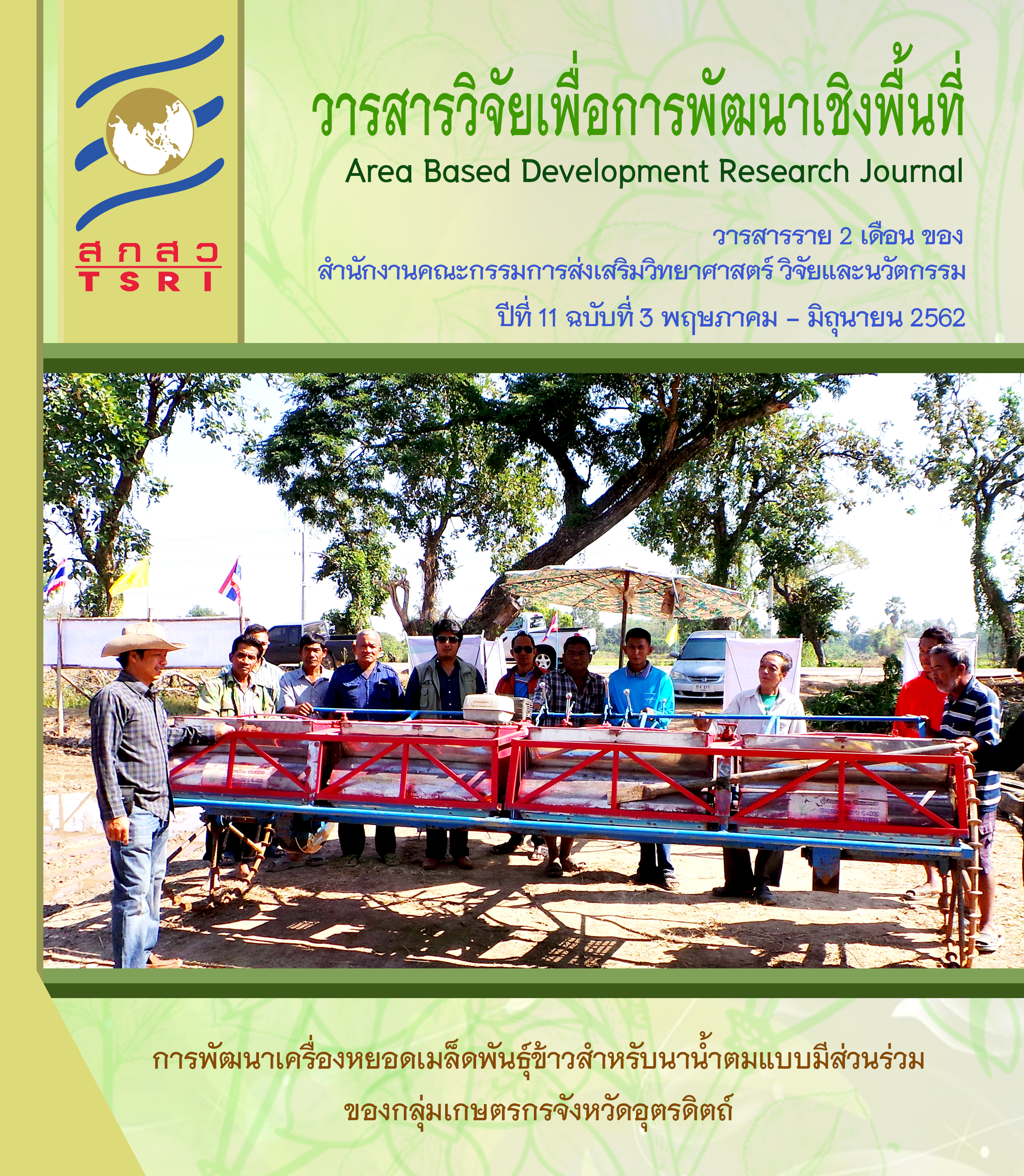The Consciousness Development of Local People Towards Local Vegetable Conservation at Mae Sai Sub-district, Phayao Province
Main Article Content
Abstract
The objective of this participatory action research is to develop the consciousness of local people on conservation of local vegetables at Mae Sai sub-district, Muang district, Phayao province. The sample group is purposive sampling from 17 health developers, 25 youth leaders and 30 household representatives from 10 areas in Mae Sai sub-district. The research method is divided into 3 phases: 1) Situation analysis, 2) Development of consciousness among the local people on conservation of local vegetables of which participation process comprising 6 activities: forest ordination activities, cross-age activities between the elderly and children, campaign for local vegetable and local food consumption, young detective activities, campaign on vegetable-eating kids, activities towards edible waste, and 3) Lesson learned. For qualitative data collection, several instruments are employed. First, to assess the community ways of life, seven tools are in use: mapping, history, calendar, interesting people, family tree, health system, and the community organization. Data are collected by in-depth interview techniques and questionnaire, and analyzed through word-by-word transcription with triangular technique and content analysis techniques. The quantitative data are collected by questionnaire to measure the youth’s consciousness levels towards community development, and analyzed with t-test analysis. The study reveals that the health developers feel happy, are proud, and appreciate the value of local wisdom. That is why they brainstorm and organize activities to promote local vegetables conservation for children, youth and people in the community. The findings reflect that the youths, after the activities, have significantly improved the awareness level of value appreciation at 0.001, and the level of perception and response at 0.05. It is also found that 46 percent of parents whose children are under the Children Development Center do not prepare crunchy snacks in their child’s school bags. Instead, they create a menu from vegetables for children at home. Then the community develops regulations in order to grow vegetables at home, to build edible fences, and to sell organic vegetables and to manage the wet waste.
Article Details
References
โกมาตร จึงเสถียรทรัพย์, คณิตสร เต็งรัง และ ราตรี ปิ่นแก้ว. (2559). วิถีชุมชนเครื่องมือ 7 ชิ้นที่ทําให้งานชุมชนง่าย ได้ผลและสนุก. (พิมพ์ครั้งที่ 12). นนทบุรี: สุขศาลา.
ฉัตรทิพย์ นาคสุภา. (2529). แนวคิดการพัฒนาแบบพึ่งตนเอง บ้านกับเมือง. กรุงเทพมหานคร: สร้างสรรค์ จํากัด.
ชณิตา ประดิษฐ์สถาพร. (2555). สุขภาวะครอบครัวสู่สุขภาวะชุมชน. คณะพยาบาลศาสตร์ มหาวิทยาลัยพะเยา. พะเยา.
ชณิตา ประดิษฐ์สถาพร. (2556). การพัฒนาระบบสุขภาพชุมชนด้านการป้องกันเบาหวานด้วยอาหารวิถีล้านนา (รายงานการวิจัย). คณะพยาบาลศาสตร์ มหาวิทยาลัยพะเยา. พะเยา.
ชณิตา ประดิษฐ์สถาพร. (2559). ระบบสุขภาพชุมชนด้านการป้องกันเบาหวานด้วยอาหารวิถีล้านนา. ใน ปิยะวัติ บุญหลง (บ.ก.), ประมวลบทความวิชาการเพื่อสังคม. (น.38-41). กรุงเทพมหานคร: พันธกิจสัมพันธ์มหาวิทยาลัยกับสังคม.
ชุติมา พิชิตรณชัยกุล และ สากล สถิตวิทยานันท์. (2557). การเข้าสู่งานอาสาสมัครและบทบาทของอาสาสมัครในสถานสงเคราะห์เด็กอ่อนพิการทางสมองและปัญญาจังหวัดนนทบุรี. วารสารวิทยาลัยราชสุดาเพื่อการวิจัยและพัฒนาคนพิการ, 10(3), 4-12.
ธงรบ ขุนสงคราม. (2561). การประยุกต์ใช้ภูมิปัญญาท้องถิ่นในการอนุรักษ์ฟื้นฟูป่าชุมชน กรณีศึกษา: ศูนย์อุดมศึกษาฯ ปะคํา ตําบลหูทํานบ อําเภอปะคํา จังหวัดบุรีรัมย์. รายงานสืบเนื่องจากการประชุมวิชาการ (proceeding) การประชุมวิชาการระดับชาติและนานาชาติ ครั้งที่ 2 มหาวิทยาลัยราชภัฎบุรีรัมย์. สืบค้นเมื่อ 12 สิงหาคม 2559, จาก https://dspace.bru.ac.th/xmlui/handle/123456789/3924.
ธีราพร ทองปัญญา. (2558). จิตสํานึกต่อการพัฒนาชุมชนของเยาวชน: กรณีศึกษา กลุ่มเยาวชนอาสาสมัครพัฒนาชุมชนห้วยหมอนทอง. วิทยาสารเกษตรศาสตร์ สาขาสังคมศาสตร์, 36(3), 483-497.
ปภาพินท์ รุณธาตุ, วัลนิกา ฉลากบาง, จํานง วงษ์ชาชม และ พรเทพ เสถียรนพเก้า. (2559). การพัฒนาจิตสาธารณะด้วยกระบวนการเรียนรู้จากประสบการณ์ของผู้นํานักเรียน ชั้นมัธยมศึกษาตอนต้น สังกัดสํานักงานเขตพื้นที่การศึกษาประถมศึกษาสกลนคร เขต 3. วารสารมหาวิทยาลัยนครพนม, 6(2), 25-32.
พนารัตน์ มาศฉมาดล. (2560). การถอดบทเรียนการพัฒนากติกาชุมชนเพื่อการใช้ทรัพยากรธรรมชาติร่วมเพื่อความยั่งยืน: ศึกษากรณีเครือข่ายโครงการรักษ์ป่าโคกหลวง องค์การบริหารส่วนตําบลสวนหม่อน อําาเภอมัญจาคีรี จังหวัดขอนแก่น. กรุงเทพมหานคร: สถาบันพระปกเกล้า.
วรรณิภา สันป่าแก้ว และ ชื่นชนก โควิทน์. (2557). แนวทางการเสริมสร้างจิตสํานึกด้านการอนุรักษ์พลังงานของเยาวชน. วารสารอิเล็คทรอนิกส์ทางการศึกษา, 9(2), 438-451.
วิลาสินี วิเชียรรัตน์. (2544). ร่วมปฏิรูปการเรียนรู้กับครูต้นแบบ: การปฏิรูปการเรียนรู้ที่เน้นผู้เรียนเป็นสําคัญ การสอนแบบมีส่วนร่วม.
กรุงเทพมหานคร: สําานักงานคณะกรรมการการศึกษาแห่งชาติ.
สถิติโรงพยาบาลส่งเสริมสุขภาพตําบลแม่ใส. (2558). รายงานข้อมูลสุขภาพประจําาปีงบประมาณ 2557. พะเยา: เอกสารอัดสําเนา.
สรายุทธ คาน และ สมกูล ถาวรกิจ. (2560). รูปแบบการอนุรักษ์สิ่งแวดล้อมของชุมชนกรณีศึกษา: ชุดโครงการวิจัยและพัฒนาการเรียนการสอนวิทยาศาสตร์ท้องถิ่น เครือข่ายมหาวิทยาลัยราชภัฎ. วารสารสารสนเทศ, 16(2), 169-180.
สาโรจน์ พานิชชานนท์, สุรสิทธิ์ วชิรขจร, สมศักดิ์ สุวรรณสุจริต และ ธวัชชัย ศุภดิษฐ์. (2554). การมีส่วนร่วมในโครงการตามกรอบแนวคิดเศรษฐกิจพอเพียงการเปลี่ยนแปลงจิตสํานึกและพฤติกรรมการอนุรักษ์ป่าต้นน้ําของชาวไทยภูเขาเผ่ากระเหรี่ยง หมู่บ้านป่าละอู. วารสารการจัดการสิ่งแวดล้อม, 7(1), 59-74.
สํานักงานคณะกรรมการวิจัยแห่งชาติ. (2555). ยุทธศาสตร์การวิจัย (พ.ศ. 2555 – 2559): ภาคเหนือ. สืบค้นเมื่อ 10 พฤษภาคม 2562 จาก file:///E:/New%20folder/research_plan_north.pdf.
สุภาวรรณ วงค์คาจันทร์ และ บุญแสน เตียวนุกูลธรรม. (2559). การใช้ประโยชน์ อนุรักษ์และฟื้นฟูทรัพยากรน้ําอย่างมีสมดุล. วารสารวิจัยราชภัฎพระนคร สาขาวิทยาศาสตร์และเทคโนโลยี, 11(2), 108-124.
เหมือนฝัน นาครทรรพ และ ธีรพัฒน์ วงศ์คุ้มสิน. (2556). สัมพันธภาพทางสังคม พรหมวิหาร 4 การรับรู้คุณลักษณะของงานและความสุขในการทํางานของอาสาพัฒนาชุมชน จังหวัดนนทบุรี. วารสารสังคมศาสตร์และมนุษย์ศาสตร์, 39(2), 120-135.
อรุณรุ่ง ปภาพสิษฐ, ทิวัฒน์ มณีโชติ, สายฤดี วรกิจโภคาทร และ วิรัตน์ คําศรีจันทร. (2555). รูปแบบการสร้างจิตสํานึกในการพัฒนาชุมชน. วารสารวิจัยราชภัฎพระนคร, 7(2), 98-110.
อุดมพงษ์ เกศศรีพงษ์ศา, จาริณี ม้าแก้ว, สรรพเพช เพียรจัด, ธัญรัศม์ ยุทธสารเสนีย์ และ ผกามาศ มูลวันดี. (2560). รูปแบบการสร้างจิตสํานึกท้องถิ่นเพื่ออนุรักษ์ป่าชุมชนอย่างยั่งยืน ตําบลโคกกลาง อําาเภอลําปลายมาศ จังหวัดบุรีรัมย์. วารสารวิจัยและพัฒนา มหาวิทยาลัยราชภัฎบุรีรัมย์, 12(1), 59-71.
Colorafi, K. J., & Evans, B. (2016). Qualitative descriptive methods in health science research. HERD: Health Environments Research & Design Journal, 9(4), 16-25.
Kolb, D. A. (1984). Experiential learning: Experience as the source of learning and development. Englewood Cliffs. NJ: Prentice Hall.
Krathwohl, D. R., Bloom, B. S., & Masia, B. B. (1964). Taxonomy of educational objectives: Handbook II: Affective domain. New York:David McKay Co.
